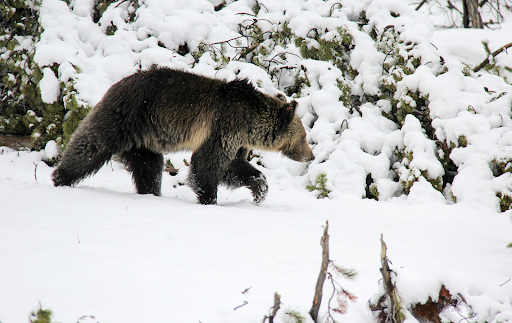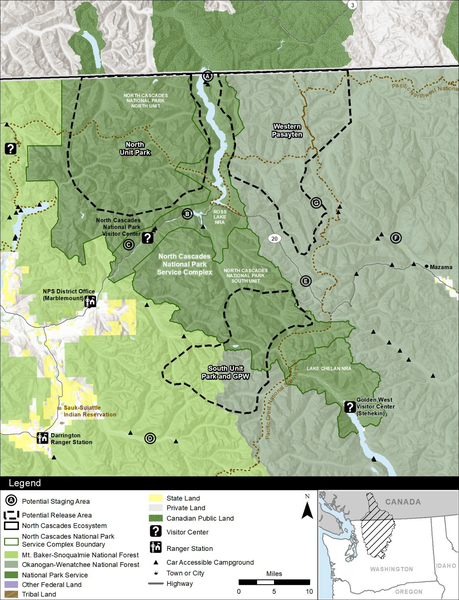
Update: Federal land managers have released the final environmental impact statement, evaluating options for restoring grizzlies to the North Cascades. This is not a final decision, but rather an evaluation of the impacts of possible actions. We’ll keep our community updated on future developments in this process.
Grizzly bears once roamed the old-growth forests and alpine meadows of Washington’s North Cascades, but their population has dwindled over the last 200 years due to hunting, trapping, and habitat loss. Today, a grizzly bear sighting in the North Cascades Ecosystem is extremely rare. But that rarity may change due to an ongoing effort by federal agencies to recover the grizzly population.
Since 1975, grizzly bears have been listed as “threatened” under the Endangered Species Act. Recognizing that the North Cascades Ecosystem is one of the last spots in the Lower 48 states where grizzlies can thrive, federal agencies like the National Park Service (NPS) and the U.S. Fish and Wildlife Service (USFWS) have been working since 1997 to develop a plan to reintroduce bears to the region. The agencies’ latest attempt to move the needle on grizzly reintroduction was made available to the general public earlier this year.
A New Plan for Grizzly Bear Recovery
In September, the NPS and USFWS released a draft restoration plan and environmental impact statement that proposed three potential management strategies for grizzly reintroduction. The first option, Alternative A, would mean that federal agencies take no action to restore the grizzly population. Most wildlife biologists say that grizzlies are already “functionally extinct” in the North Cascades Ecosystem, so without action, the population would likely not be restored.
Under the two other proposed management options, Alternative B and C, federal agencies would take action to reintroduce grizzlies. Each summer, a few grizzly bears would be relocated from well-established populations like Yellowstone to the North Cascades region. Once the grizzly population reaches 25 bears, the management phase would begin. Federal agencies would monitor the grizzly population, and only introduce more bears if the population dropped significantly. The long-term vision under Alternative B and C is that those initial 25 grizzlies would grow to a stable population of about 200 bears over the next century.
The key difference between Alternative B and C is in how land managers would be allowed to manage and monitor the bear population. Under Alternative B, the reintroduced grizzlies would be managed under the Endangered Species Act, meaning options for dealing with bears would be fairly limited.
On the other hand, Alternative C would give land managers more flexibility than Alternative B to relocate, capture, and manage bears. If a grizzly wandered off federal land or strayed too close to people’s homes, land managers would have more options to relocate or deter that bear. Federal agencies added this new management option to help alleviate concerns over grizzly reintroduction.
Potential Impacts of Grizzly Reintroduction on Recreation
If the Park Service decides to reintroduce grizzlies, most of the bears will be released on public lands north of Interstate 90, an area of about 9,800 miles. That area is large enough that human interaction with bears will probably be limited.
Long-term closures that would affect public access to trails, peaks, and other recreational opportunities in the North Cascades Ecosystem would also be highly unlikely. Although the NPS may close areas to keep recreationists safe, we expect those closures to be temporary and localized. But, as the grizzly population grows, the potential for closures and human-bear interaction may also grow - especially in the backcountry.
The Mountaineers Comments on Grizzly Reintroduction
We want to make sure that land managers have the tools they need to manage bears if the Park Service decides to move ahead with their plans to restore the grizzly population. That’s why The Mountaineers worked with our partners to write a letter to Don Striker, the Superintendent of the North Cascades National Park Service Complex, with our input on grizzly reintroduction.
We told the Park Service that we prefer Alternative C to Alternative B if grizzlies are reintroduced. Alternative C gives land managers more flexibility to manage bears, and we believe that the added flexibility will help limit trail closures and safety concerns in the North Cascades Ecosystem. We’ve also asked the North Cascades National Park to provide more information on how bear reintroduction may impact backcountry travel and recreation in general. We want to make sure that recreation considerations are fully incorporated into the final management plan so that our community can continue to safely access outdoor opportunities throughout the North Cascades.

Potential grizzly release areas in the North Cascades Ecosystem. Image by the U.S. Fish and Wildlife Service and the National Park Service.
Recreating Safely in Bear Country
Regardless of whether grizzly bears are reintroduced to the North Cascades, it’s important to know how to safely recreate in bear country. Black bears already call the Cascades home and are prevalent in the area.
Best practices for traveling safely through bear country are largely the same for black bears and grizzlies. They include hiking in groups, making noise to announce yourself, bear-proofing your campsite during overnight stays, carrying bear spray, and keeping an eye out for bear signs such as scat or tracks.
In the rare event that you experience bear aggression, it’s important to know the proper way to respond, which can vary depending on the species of bear. During an aggressive encounter with a grizzly, you should play dead. With black bears, you should escape or fight back. Bear attacks are highly unusual, but being prepared for this worst-case scenario will help keep you safe in bear country.
And remember, most bears don’t want anything to do with you. As long as you take reasonable precautions and recreate responsibly, you’ll be able to enjoy the beauty of the North Cascades, even if the park’s “local residents” are nearby.
Check out the National Park Service’s news release and the draft grizzly bear restoration plan and environmental impact statement to learn more about the proposed plan to restore grizzly bears to the North Cascades. For more information on recreating in bear country, check out North Cascades National Park’s comprehensive bear safety guide.
 The Mountaineers
The Mountaineers